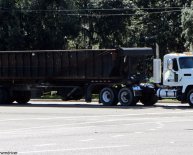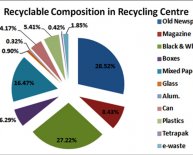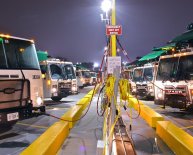
Improper Solid Waste Disposal
Once collected, municipal solid waste may be treated in order to reduce the total volume and weight of material that requires final disposal. Treatment changes the form of the waste and makes it easier to handle. It can also serve to recover certain materials, as well as heat energy, for recycling or reuse.
Composting
Another method of treating municipal solid waste is composting, a biological process in which the organic portion of refuse is allowed to decompose under carefully controlled conditions. Microbes metabolize the organic waste material and reduce its volume by as much as 50 percent. The stabilized product is called or . It resembles potting soil in texture and odour and may be used as a soil conditioner or mulch.
Composting offers a method of processing and recycling both garbage and sewage in one operation. As more stringent environmental rules and siting constraints limit the use of solid-waste incineration and landfill options, the application of composting is likely to increase. The steps involved in the process include sorting and separating, size reduction, and digestion of the refuse.
Sorting and shredding
The decomposable materials in refuse are isolated from glass, metal, and other inorganic items through sorting and separating operations. These are carried out mechanically, using differences in such physical characteristics of the refuse as size, density, and magnetic properties. Shredding or pulverizing reduces the size of the waste articles, resulting in a uniform mass of material. It is accomplished with hammer mills and rotary shredders.
Digesting and processing
Pulverized waste is ready for composting either by the open windrow method or in an enclosed mechanical facility. Windrows are long, low mounds of refuse. They are turned or mixed every few days to provide air for the microbes digesting the organics. Depending on moisture conditions, it may take five to eight weeks for complete digestion of the waste. Because of the metabolic action of aerobic bacteria, temperatures in an active compost pile reach about 65 °C (150 °F), killing pathogenic organisms that may be in the waste material.
Open windrow composting requires relatively large land areas. Enclosed mechanical composting facilities can reduce land requirements by about 85 percent. Mechanical composting systems employ one or more closed tanks or digesters equipped with rotating vanes that mix and aerate the shredded waste. Complete digestion of the waste takes about one week.
Digested compost must be processed before it can be used as a mulch or soil conditioner. Processing includes drying, screening, and granulating or pelletizing. These steps improve the market value of the compost, which is the most serious constraint to the success of composting as a waste management option. Agricultural demand for digested compost is usually low because of the high cost of transporting it and because of competition with inorganic chemical fertilizers.
Sanitary landfill
Land disposal is the most common management strategy for municipal solid waste. Refuse can be safely deposited in a sanitary landfill, a disposal site that is carefully selected, designed, constructed, and operated to protect the environment and public health. One of the most important factors relating to landfilling is that the buried waste never comes in contact with surface water or . Engineering design requirements include a minimum distance between the bottom of the landfill and the seasonally high . Most new landfills are required to have an impermeable liner or barrier at the bottom, as well as a system of groundwater-monitoring wells. Completed landfill sections must be capped with an impermeable cover to keep precipitation or away from the buried waste. Bottom and cap liners may be made of flexible membranes, layers of soil, or a combination of both.
Constructing the landfill
The basic element of a sanitary landfill is the refuse cell. This is a confined portion of the site in which refuse is spread and compacted in thin layers. Several layers may be compacted on top of one another to a maximum depth of about 3 metres (10 feet). The compacted refuse occupies about one-quarter of its original loose volume. At the end of each day’s operation, the refuse is covered with a layer of soil to eliminate windblown litter, odours, and insect or rodent problems. One refuse cell thus contains the daily volume of compacted refuse and soil cover. Several adjacent refuse cells make up a lift, and eventually a landfill may comprise two or more lifts stacked one on top of the other. The final cap for a completed landfill may also be covered with a layer of topsoil that can support vegetative growth.
Daily cover soil may be available on-site, or it may be hauled in and stockpiled from off-site sources. Various types of heavy machinery, such as crawler tractors or rubber-tired dozers, are used to spread and compact the refuse and soil. Heavy steel-wheeled compactors may also be employed to achieve high-density compaction of the refuse.
The area and depth of a new landfill are carefully staked out, and the base is prepared for construction of any required liner and leachate-collection system. Where a plastic liner is used, at least 30 cm (12 inches) of sand is carefully spread over it to provide protection from landfill vehicles. At sites where excavations can be made below grade, the trench method of construction may be followed. Where this is not feasible because of topography or groundwater conditions, the area method may be practiced, resulting in a mound or hill rising above the original ground. Since no ground is excavated in the area method, soil usually must be hauled to the site from some other location. Variations of the area method may be employed where a landfill site is located on sloping ground, in a valley, or in a ravine. The completed landfill eventually blends in with the landscape.
Controlling by-products
Organic material buried in a landfill decomposes by anaerobic microbial action. Complete decomposition usually takes more than 20 years. One of the by-products of this decomposition is gas. Methane is poisonous and explosive when diluted in the air, and it can flow long distances through porous layers of soil. If it is allowed to collect in basements or other confined areas, dangerous conditions may arise. In modern landfills, methane movement is controlled by impermeable barriers and by gas-venting systems. In some landfills the methane gas is collected and recovered for use as a fuel.

















